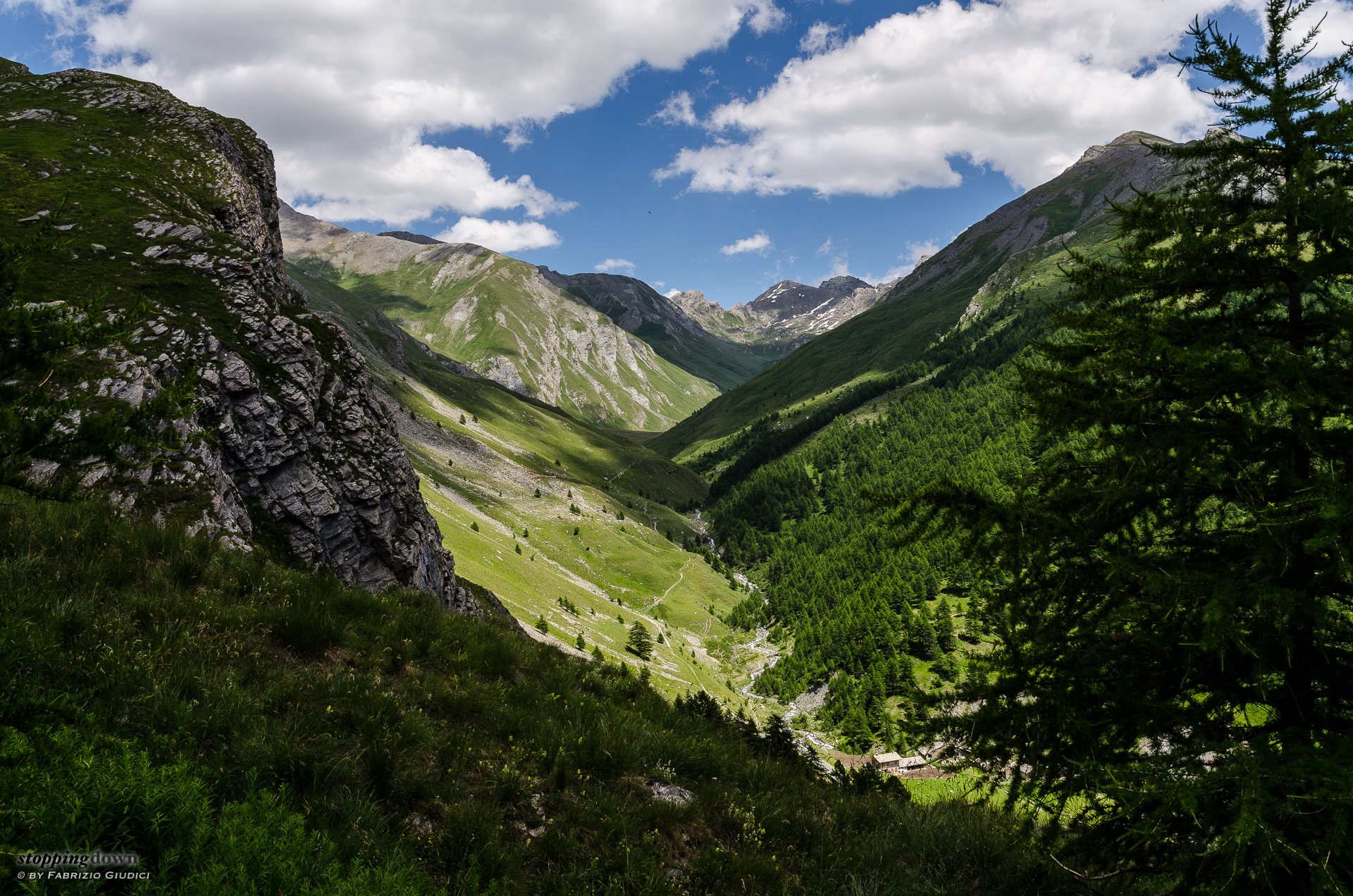When I made my first choices for building my lens arsenal, more than ten years ago, I went for primes: currently I own a 8mm fish-eye ƒ/3.5, a 35mm ƒ/1.8, a 50mm ƒ/1.8, an 85mm ƒ/1.8, a 180mm ƒ/2.8 and a 300mm ƒ/4. They are excellent lenses, tack sharp yet affordable. Years ago there weren't simply alternative zoom lenses matching the optical performance of primes and not being too expensive. The only exception to the rule are items such as the zoom 12-24mm ƒ/4, that in fact I bought to cover the wide-angle range. This set is pretty complete and until a few time ago I didn't feel like I needed to buy other stuff (perhaps I miss a macro in the range of 100mm, but this is another story).
Nikon D5100 + Nikkor 18-70mm ƒ/3.5-4.5G ED DX AF-S @ 22 mm, 1/250 sec @ ƒ/11, -1.00 EV, ISO 125
Il Vallone di Soustra.
The problem with prime lenses is that you have to change them frequently and to carry a number of items along
with you. In particular the latter is becoming a real problem, as flight baggage costs more and more and I feel a
bit more fatigued when I have to pack everything for a travel; with the consequence than often I only feel about
carrying one or two lenses and my smallest camera (the Nikon D5100) for short business travels. Unfortunately,
this is a serious constraint that made me miss a number of photo opportunities. In a few words, I've started
feeling the need of going lightweight.
Nikon D5100 + Nikkor 18-70mm ƒ/3.5-4.5G ED DX AF-S @ 40 mm, 1/250 sec @ ƒ/11, -0.67 EV, ISO 200
Il Vallone di Soustra.
So I evaluated the possibility of buying a zoom lens for a set of common focal lengths, searching for something that is still very sharp and luminous (no worse than ƒ/4). I'll always have a preference for primes, but the zoom could help in those cases I want to stay light. After reading some reviews, in particular at bythom's, I went for the AF-S Zoom-Nikkor ED 18-70mm f/3.5-4.5G IF DX.
Nikon D7000 + Nikkor 18-70mm ƒ/3.5-4.5G ED DX AF-S @ 70 mm, 1/160 sec @ ƒ/8, -1.00 EV, ISO 160
Fort Queyras dans le soleil du matin.
According to the review, the lens is sharp but suffers from a moderate geometric distortion: nothing really important as Lightroom can automatically fix it. The focal range is good enough and honestly one can't ask for a good lens with a very wider range; too bad for the 18-135mm, which according to the same site is even sharper, but suffers from an overall chromatic aberration that jeopardizes its quality.
Nikon D7000 + Nikkor 18-70mm ƒ/3.5-4.5G ED DX AF-S @ 70 mm, 1/250 sec @ ƒ/8, -1.67 EV, ISO 100
Le Guil près de Château-Queyras.
Speaking of the focal length alone, the 18-70mm can replace “half” of the 12-24mm, the 35mm, the 50mm and more or less the 85mm; roughly 3 lenses and half.
Nikon D5100 + Nikkor 18-70mm ƒ/3.5-4.5G ED DX AF-S @ 50 mm, 1/400 sec @ ƒ/8, -0.67 EV, ISO 140
L'erba è più buona sull'altro lato della strada.
A first, quick and subjective set of shoots proved that the lens is sharp enough, even though at first look — as expected — it's inferior to the primes it replaces. But if the alternative is between taking photos that are a bit less sharp and not taking them at all... well, the conclusion is clear.
Nikon D5100 + Nikkor 18-70mm ƒ/3.5-4.5G ED DX AF-S @ 18 mm, 1/320 sec @ ƒ/8, -0.67 EV, ISO 100
Cavalli al pascolo sotto il Pan di Zucchero.
The past week I was in the western Alps and I constrained myself not to use the prime lenses, to have a good
bunch of evaluating shots for my new 18-70mm. Some of the most interesting examples are illustrated in this blog
post.
Nikon D5100 + Nikkor 18-70mm ƒ/3.5-4.5G ED DX AF-S @ 48 mm, 1/200 sec @ ƒ/8, -0.33 EV, ISO 100
La Casse Déserte.
I tested the new lens both with the D7000 and the D5100 — they are practically identical from the sensor point of
view. The perfect match, though, seems to be the D5100 as it's smaller and compact.
All in all, it has been a good experience; I had all my lenses with me and perhaps some photo could have enjoyed
the superb quality of a 35mm or 50mm prime, but I could have missed some shot for the laziness of not changing the
lens every few minutes. In any case, to better evaluate the quality of the 18-70mm, I've planned to run a more
comprehensive and objective side-by-side evaluation with the other lenses.

















